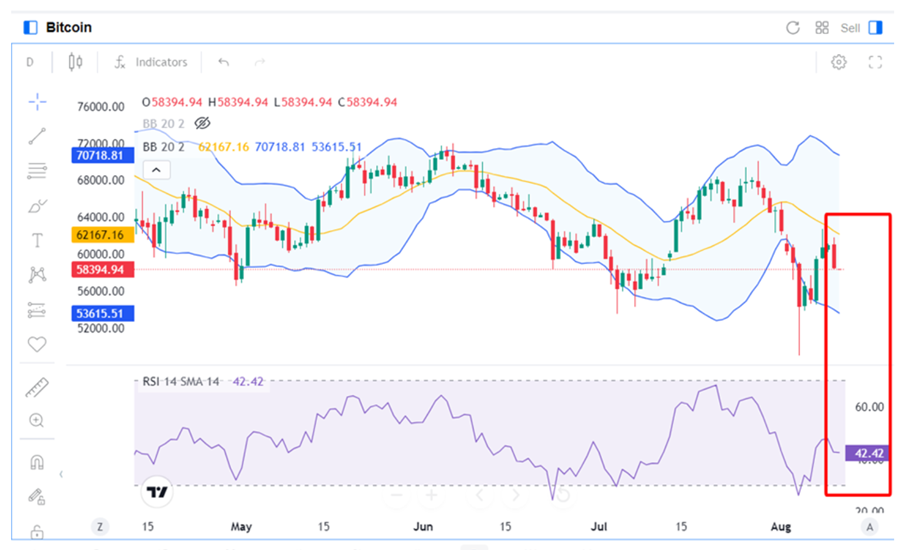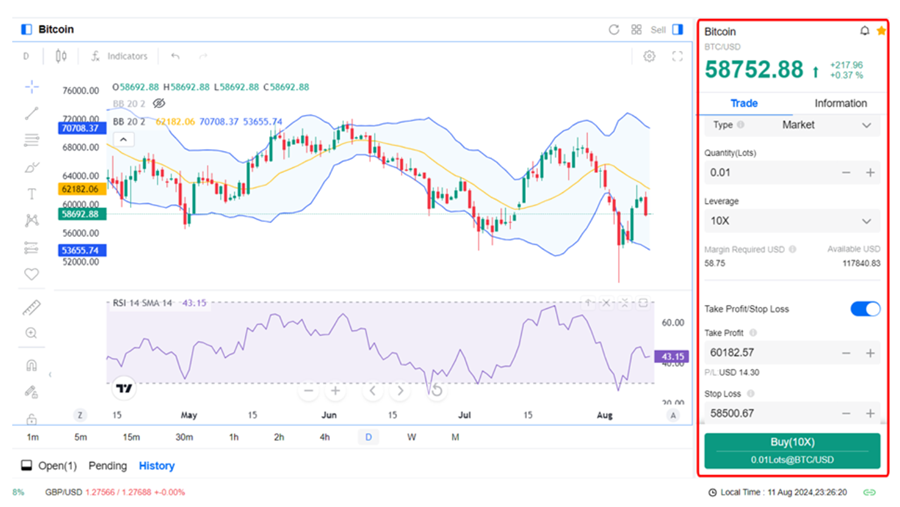
Swing trading is a popular strategy in the world of financial markets, offering a middle ground between day trading's fast pace and long-term investing's patience. For those intrigued by the idea of capturing short- to medium-term gains from market fluctuations, swing trading might be the perfect approach.
In this article, we'll explore what swing trading is, how it works, and the key principles that can help you decide if it's the right strategy for your trading goals. Whether you're a seasoned trader or just starting out, understanding swing trading can add a valuable tool to your investment arsenal.
1. What is swing trading?
Swing trading is a trading strategy that involves holding positions in financial markets—such as stocks, commodities, or cryptocurrencies—for a period of several days to a few weeks. The primary goal of swing trading is to capitalize on short- to medium-term price movements, typically capturing swings within an existing trend.
Unlike day trading, which involves buying and selling within the same day, or long-term investing, where positions may be held for months or years, swing trading strikes a balance between the two. Traders aim to take advantage of price fluctuations by identifying potential entry and exit points based on technical analysis, patterns, and market trends.
Key characteristics of swing trading include:
Time frame: Swing traders typically hold their positions from a few days to a few weeks, depending on how long the trend of price movement lasts.
Market analysis: Swing traders typically use technical analysis, using tools like moving averages, trend lines, and chart patterns to identify potential opportunities. Some also incorporate fundamental analysis to understand broader market conditions.
Risk management: Since swing trading involves holding positions overnight, traders are exposed to market risks such as gaps and news events that can impact prices. Effective risk management strategies, such as stop-loss orders, are crucial to protecting capital.
Flexibility: Swing trading can be adapted to various markets, including stocks, forex, commodities, and cryptocurrencies.
Swing trading requires a good understanding of market dynamics, technical analysis, and disciplined risk management. The following sections will guide you how to start swing trading and practice with real examples.
2. How to start swing trading and practice with real examples
Starting swing trading involves several steps, including education, strategy development, and practice. Here’s a guide to help you get started, along with a suggestion on how to practice with real examples:

Educate yourself
Learn the basics: Understand what swing trading is, how markets work, and the key concepts like support and resistance, trend lines, moving averages, and chart patterns.
Study technical analysis: Since swing trading relies heavily on technical analysis, learn how to read charts, recognize patterns, and use indicators such as RSI, MACD, and Bollinger Bands.
Understand risk management: Learn about position sizing, stop-loss orders, and how to manage your risk per trade.
Choose a market and assets
Market selection: Decide whether you want to trade stocks, forex, commodities, or cryptocurrencies. Each market has its own characteristics and requires specific strategies.
Instrument selection: Choose specific assets or securities within your chosen market. For example, if you’re trading stocks, you might focus on high-liquidity stocks with significant price swings.
Develop a swing trading strategy
Define your trading plan: Set clear rules for entering and exiting trades, including criteria for buying (e.g., when a stock breaks out above resistance) and selling (e.g., when a target profit or stop-loss level is reached).
Test your strategy: Backtest your strategy on historical data to see how it would have performed in different market conditions.
The commonly used strategy in swing trading will be detailed in Section 4 of this article.
Practice
Choose a broker and Open a Demo account:
The best way to practice swing trading, especially for beginners, is by using a demo account, which is provided by most brokers. This account provides you with a certain amount of virtual money (e.g., Mitrade's demo account with 50,000 virtual USD), allowing you to practice trading in real-time market conditions. When you’ve built up enough confidence, you can easily switch to a live account, where you'll trade with real money in the same real-time market conditions you've been practicing in.
After opening a demo account, stick to the market and assets you initially chose for trading. For example, if you choose the cryptocurrency market, start trading with Bitcoin.
Analyze the price trend

Bitcoin price chart (Source: Mitrade)
The trader uses two indicators, Bollinger Bands and RSI, along with the daily timeframe, to anticipate price movements. In the Bitcoin chart above, after the downward trend, the price drops to the lower band and starts to recover, but it could not break above the MA20. This indicates that the price is still in a downward trend, and it could be risky to buy at this time. However, the trader can expect the price to stall for one or two sessions after three consecutive bullish sessions before potentially breaking above the MA20 to continue the upward trend.
Open a trading position:

Based on the price trend analysis, the trader can open a buy position with a small quantity (e.g., 0.01 lot) and moderate leverage (e.g., 1:10). Simultaneously, use take-profit and stop-loss orders to manage risk.
Monitor and review:
To effectively manage your trading position, monitor price movements and key indicators in real-time, adjusting stop-loss and take-profit levels as needed.
Regularly review the trade's performance against your initial plan and stay updated on market conditions that may impact the asset. After closing the position, document the trade in a journal and reflect on the outcomes to improve future strategies.
Note: Traders can use a demo account to practice and understand how the market works, as well as to test their price trend analysis. However, for short-term holds, it's crucial to wait for a clear trend before opening a position to increase the likelihood of success.
By following these steps and practicing with real examples, you'll develop the skills and confidence needed to swing trade effectively.
3. The best times to swing trade
Timing plays a crucial role in swing trading to optimize potential profits and reduce risks. While swing trading is not as time-sensitive as day trading, certain periods within the trading day, week, and year can offer more favorable conditions for swing trading. Here's a breakdown of the best times to swing trade:
Time of Day
Opening Hours (9:30 AM to 10:30 AM EST in the U.S): This time is often the most volatile due to the release of news, overnight orders, and the reaction to the previous day’s trading. This can provide good opportunities for swing traders to enter positions as new trends might start to form. However, due to this volatility, it's important to wait for the initial price swings to settle before making any decisions. Observing the market's behavior during the first 30 minutes can provide valuable insights into potential trading opportunities.
Midday (11:30 AM to 2:00 PM EST): Midday trading tends to be slower and less volatile as many traders take breaks and wait for new developments. This is usually not the best time to enter new positions but can be a good time to monitor existing trades and set alerts.
Closing Hours (3:00 PM to 4:00 PM EST): This time is another period of increased volatility as traders adjust their positions before the market closes. Swing traders might find opportunities to enter or exit trades during this time, especially if there's strong momentum. It’s also a good time to prepare for potential overnight holds, as you can gauge the market sentiment heading into the next trading day.
Days of the Week
Tuesday to Thursday: Historically, Tuesday to Thursday tends to be the most stable and active trading days. Monday mornings can be unpredictable due to weekend news, and Friday afternoons often see reduced activity as traders close out positions before the weekend.
Many swing traders prefer entering trades on Tuesday or Wednesday after the market has settled from Monday’s opening, and they aim to close positions before Friday’s close to avoid weekend risk.
Times of the Month
Beginning and middle of the month: The beginning and middle of the month often see more trading activity, partly due to the release of economic data such as employment reports, inflation numbers, and central bank meetings. These can create new trends or reinforce existing ones, providing good opportunities for swing trades. Many investors and fund managers make adjustments to their portfolios at these times, leading to potential price swings.
End of the month: Traders might adjust their positions based on monthly performance, which can cause increased volatility. Some traders use this period to close out trades to lock in gains or cut losses before the month-end.
Times of the Year
Earnings season (January, April, July, October): This period, when companies release their quarterly results, is one of the most dynamic times for swing trading. Positive or negative earnings surprises can cause significant price movements, presenting opportunities for swing traders. It’s essential to monitor earnings reports closely, as well as the market’s reaction to these reports.
Pre-Holiday trading: Markets can be unpredictable before major holidays (e.g., Thanksgiving, Christmas, New Year). The days leading up to holidays often see reduced trading volume, which can lead to erratic price movements. However, there can also be opportunities if there are strong trends in place. Some traders also capitalize on the so-called “Santa Claus rally” at the end of the year, where markets tend to rise.
Post-Holiday trading: After major holidays, markets may experience a surge in activity as traders return and reestablish their positions. This can create opportunities for swing trades if new trends emerge.
Economic and Political Events
Federal reserve meetings: Central bank meetings, especially those of the Federal Reserve, can lead to significant market movements. Interest rate decisions, economic outlooks, and policy changes are all catalysts that can create trading opportunities.
Geopolitical events: Elections, trade negotiations, and other geopolitical events can create uncertainty and lead to price swings in the market. While these events are harder to predict, they can offer opportunities if you understand the potential market impact.
While the timing of your trades can significantly influence your success as a swing trader, it’s important to combine timing with sound technical analysis and a well-thought-out trading strategy. Pay attention to market conditions, economic calendars, and the behavior of the assets you're trading to determine the best times to enter and exit trades.
5. Pros and Cons of Swing Trading
Pros:
Flexibility: Swing trading allows traders to hold positions for several days to weeks, providing flexibility to manage trades without the need for constant monitoring.
Potential for Significant Gains: By capturing short- to medium-term price movements, swing traders can potentially achieve substantial profits within a relatively short period.
Less Time-Intensive: Compared to day trading, swing trading requires less time in front of the screen, making it suitable for those with other commitments.
Use of Technical Analysis: Swing trading heavily relies on technical analysis, which can be a powerful tool for identifying trading opportunities and making informed decisions.
Reduced Stress: Since trades are not executed as frequently as in day trading, swing traders often experience less stress and pressure.
Cons:
Overnight and Weekend Risk: Holding positions overnight or over the weekend exposes traders to the risk of adverse price movements due to news or events that occur outside of trading hours.
Requires Strong Analytical Skills: Successful swing trading demands a solid understanding of technical analysis and the ability to interpret charts and indicators accurately.
Potential for Missed Opportunities: Since swing traders do not monitor the market constantly, they might miss out on short-term opportunities that day traders could capitalize on.
Market Volatility: Swing traders are exposed to market volatility, which can lead to unexpected price swings and potential losses.
Emotional Discipline: Maintaining emotional discipline is crucial in swing trading, as traders must stick to their strategies and avoid impulsive decisions based on short-term market fluctuations.
5. Summary
Swing trading is a versatile approach to trading that involves holding positions for several days to weeks, aiming to profit from market price swings. It blends technical analysis with strategic timing to identify entry and exit points within trending markets.
This method offers a balanced way to engage with the markets, appealing to traders who seek opportunities beyond day trading's fast pace but without the long-term commitment of traditional investing. By employing various strategies and maintaining disciplined risk management, swing traders can navigate market fluctuations and potentially achieve steady returns.
6. FAQs about swing trading
#6.1 What markets can I swing trade in?
Swing trading can be utilized across a range of markets, such as stocks, forex, commodities, and cryptocurrencies. The strategy is flexible and can be adapted to different asset classes, depending on your preference and expertise.
#6.2 How much capital do I need to start swing trading?
The amount of capital needed depends on the market you choose and your trading goals. For stocks, a common recommendation is to start with at least $1,000 to $5,000, though you can start with less in markets like forex, which often offer higher leverage. It's essential to begin with an amount you're comfortable risking.
#6.3 What are the risks of swing trading?
Swing trading involves holding positions overnight, exposing traders to potential risks from news events, earnings reports, or other factors that can cause gaps in prices. Effective risk management, including using stop-loss orders and position sizing, is crucial to mitigate these risks.
#6.4 Can I swing trade part-time?
Yes, swing trading is well-suited for part-time traders. Since it doesn't require constant monitoring like day trading, it's a good option for those who have other commitments during the day but can spend time analyzing markets and placing trades during off-hours.
#6.5 How much time should I dedicate to swing trading?
Swing trading requires less time compared to day trading but still needs regular attention. Typically, you should allocate time to analyze charts, monitor your trades, and review market news. Many swing traders spend an hour or two each day, often during the evenings, to plan their trades and make adjustments.
Before making any trading decisions, it is important to equip yourself with sufficient fundamental knowledge, have a comprehensive understanding of market trends, be aware of risks and hidden costs, carefully consider investment targets, level of experience, risk appetite, and seek professional advice if necessary.
Furthermore, the content of this article is solely the author's personal opinion and does not necessarily constitute investment advice. The content of this article is for reference purposes only, and readers should not use this article as a basis for any investment decisions.
Investors should not rely on this information as a substitute for independent judgment or make decisions solely based on this information. It does not constitute any trading activity and does not guarantee any profits in trading.
If you have any inquiries regarding the data, information, or content related to Mitrade in this article, please contact us via email: insights@mitrade.com. The Mitrade team will carefully review the content to continue improving the quality of the article.


